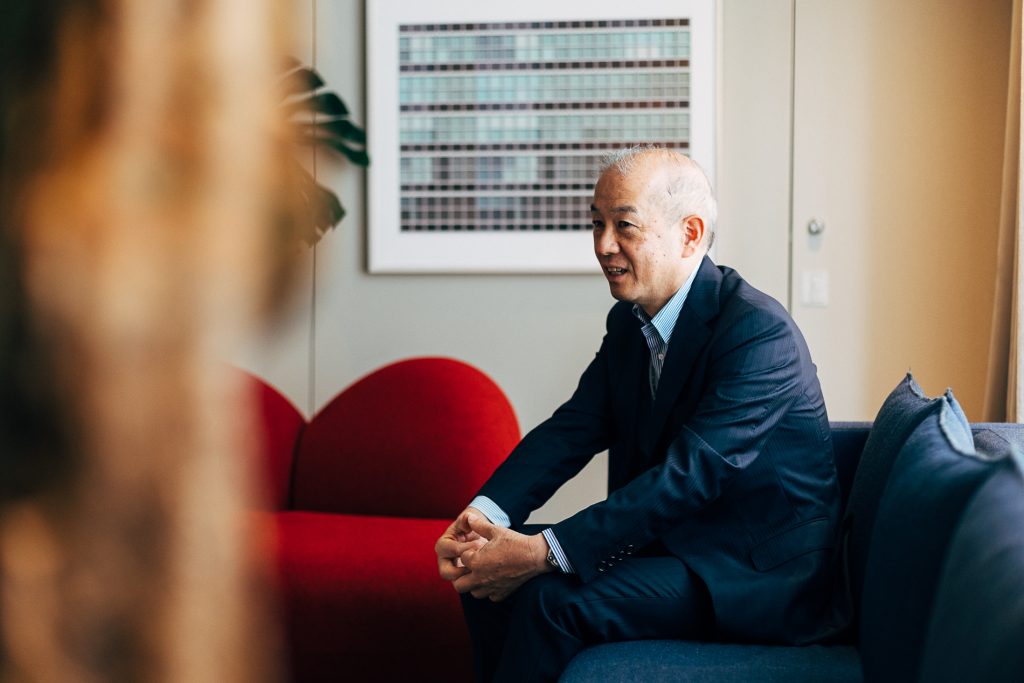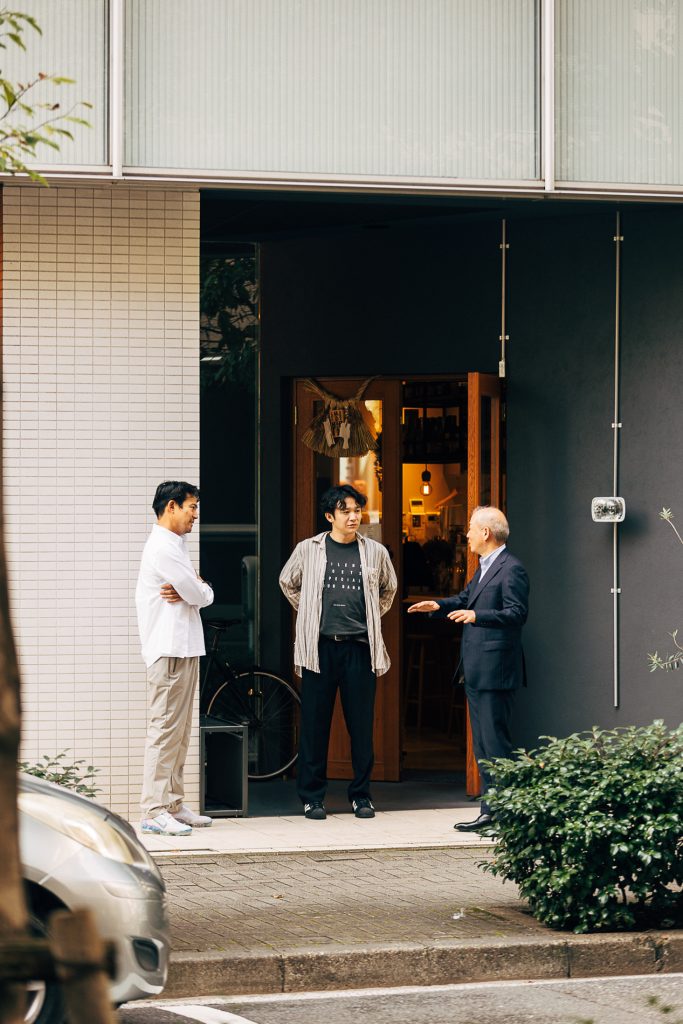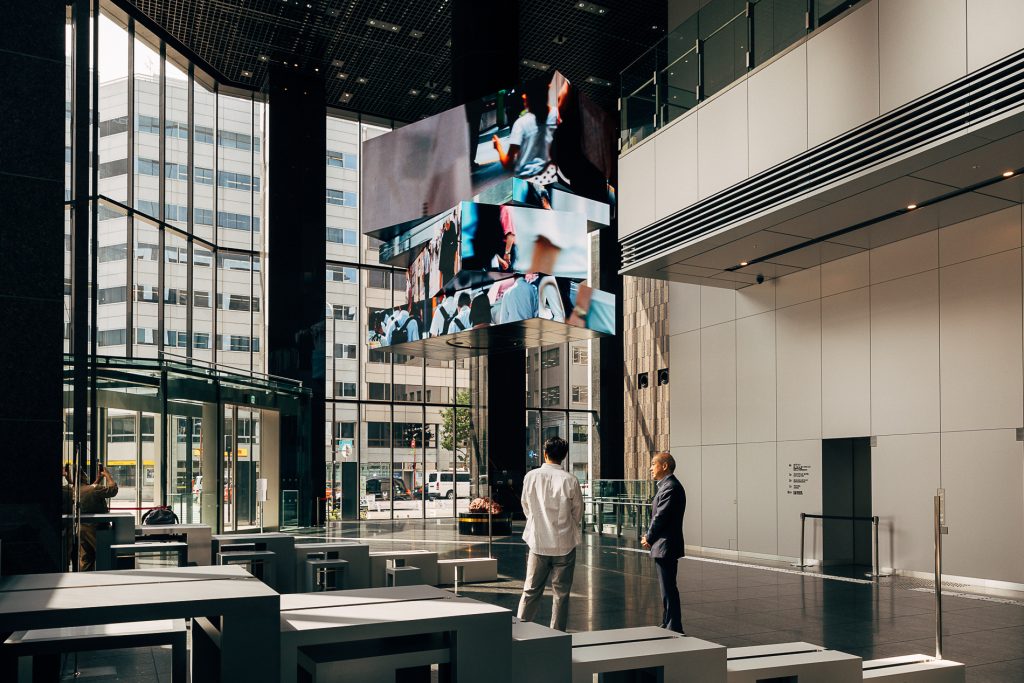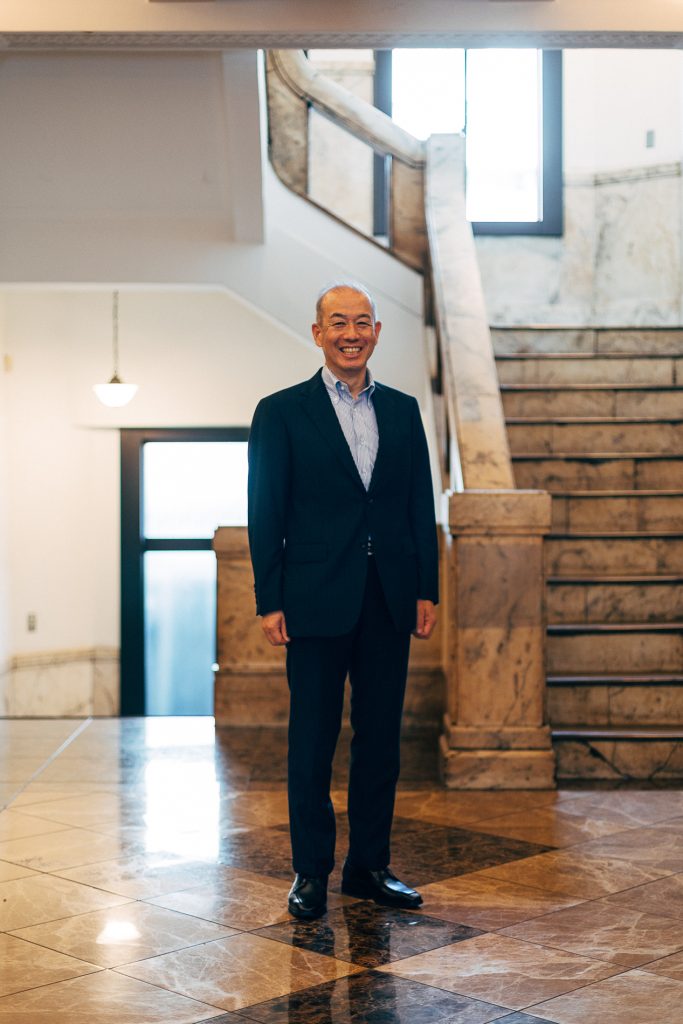


Forty years of living alongside Kabutocho,
Building a town where all roads are connected
●How do you see Kabutocho moving so far?
I have been working in this city for 40 years, and I think the developments over the past few years have been wonderful. Until it closed in 1999, the bustle of Kabutocho was on-par with the bustle of the Tokyo Stock Exchange. I have been on the trading floor since my time as a rookie employee, and I have seen over 2,000 people gather there every day. There were plenty of places for people to have lunch, and when you ordered your soba at the restaurant, your food would be served in 30 seconds; it was such an impatient town! Having experienced such an atmosphere firsthand, I was saddened to see the standing-only restaurants and bars disappear. For the past 10 years, I have been thinking about how Heiwa Real Estate can revitalize a town that has lost its liveliness, and I believe that the past year or two has been a turning point thanks to the help of our partners.
●In the ever-changing Kabutocho, are there any places that have disappeared but would be interesting to revive?
I like Japanese food, so I would like to see the revival of good eel and sushi restaurants. If you were to ask me what else I would like to see in this town, I would have to say a flower shop. Also, it would be nice to have a place where you can quickly enjoy a delicious croissant and coffee, so a bakery where you can have a light breakfast would also be on my list.
●The very next thing I’m going to build is a flower shop and a bakery, and I’m pretty excited about doing a florist pop-up at K5.
Flowers and greenery are important elements of a city, aren’t they? And I think it is very important to raise the amount and quality of green we see in the city. Since the beginning, Kabutocho lacked the quality of green, so the first thing we did was to increase the amount of planting and plants in the area. But from now on, we need to have a ‘quality of green’ perspective. Recently, Sakamotocho Park (*1) was renovated, and it is the birthplace of so-called urban parks. Eiichi Shibusawa was involved in the planning and it is said that he was very particular about the quality of the greenery.
※1 Sakamotocho Park
Located in Kabutocho, this is the first small urban park created in Japan in 1889.
●I think that the ‘quality of green’ is an indispensable perspective for urban development.
Actually, I asked an environmental design professor, who was in charge of the renewal of the park, to take a look at Kabutocho. His take on the greenery was mostly negative. He said that, from a professional point of view, the quality of the greenery was lacking. I think this was due to our lack of knowledge about planting. This is the first time for us to work on a redevelopment project, so we tend to lack experience in many areas. But as each staff member raises their level of expertise, the people who are involved will be able to raise the quality with a sense of urgency. It just so happens that I was talking about green, but I think this carries over to other fields as well. There is a saying that the ‘soul is in the details’ and I want to pay close attention to those details. I think creating a city with plenty of room is a good starting point.
●I can’t agree with you more. I think that if you pay attention to details and improve quality, you will eventually have problems with economic rationale. How do you balance those two things?
In the case of urban development, by focusing on such details, there will be temporary problems in terms of economic rationality. However, by continuing to work a little harder, even if you have to be patient, the value of the entire city will increase in the long run. I think it would be good to think of economic rationality as something like an investment, where the value comes back to us in the end.
To have an edge in the field of finance, and to satisfy our sense of fun. My experience has been applied to the two pillars I have set forth in the city development.
●That’s right, I think we should be careful to not take things too seriously in the short term.
Kabutocho, in particular, is a town that has sunk once, so I want to be very conscious of differentiating it from other towns by focusing on details. In fact, the reason why I am so interested in planting trees like this is partly that I studied the discipline of quantitative geography at university.
●What is the study of quantitative geography?
The idea is to analyze the nature of cities and land use from a quantitative aspect. The professor of my seminar was also one of Mr. Minoru Mori of Mori Building’s operational staff, and he allowed me to freely research land-related matters. I found it very inspiring. I was interested in urban development from the time I was in college, and my classmates went on to work for major real estate companies, but for some reason, I ended up working for the Tokyo Stock Exchange!
●Now, the things you studied at university are coming back in handy!
That’s right. One is to give Kabutocho an edge in the field of finance, and for that, I can fully utilize my 35 years of experience at the Tokyo Stock Exchange. The other is to satisfy my playful side, and for that, I think I can use my university experience to my advantage. I think it helps me when to make more thoughtful comments or recommendations to the relevant people in charge.
●What specific comments do you make?
About three years ago, I wrote down a list of things I would like to see in Kabutocho and passed that on to the person in charge, telling them that my comments were mostly based on my own personal tastes. The person in charge of the project replied by saying, “This part of the project is ready” and started making those things happen, one after another.
●It’s great that you are implementing real change. What ideas did you write out?
Perhaps my experiences in my first and second years of college have also helped. I had studied hard at a preparatory school in Nagoya, but when I moved to Tokyo and entered Keio University, I was surprised by the people I had never met before. They had a lot of room, enjoyed various things, had a playful spirit, and were always smiling. Not only were they smiling, but they were also frank. Laughing is something you can only do if you have room to spare. I absorbed a lot of things during my time with these smart and thoughtful people, and it made me realize that playfulness is a very important element in life.
●Are there any friends who have been particularly influential to you?
I had a friend who loved Western music. On Saturday nights, there was a program on Radio Nippon called “American Top 40” which played the top 40 Billboard songs of all time. He would send letters to the show, and they would often read them out, live on air. Thanks to him, I was immersed in Western music of the late 70s and 80s.
●What specific artists did you get into?
The Eagles, Billy Joel, Doobie Brothers, Joe Sample, REO Speedwagon, Rickie Lee Jones, and so on. There is a restaurant called Session at the Hamacho Hotel in Nihonbashi Hamacho, which is close to Kabutocho and is owned by Blue Note, and it plays music that reminds me of my youth. I’d love to have a restaurant like that in Kabutocho!
●I like that! A place like the ‘Listening Lounge’ might attract a new audience to Kabutocho. Also B, on the basement floor of K5, has great sound and is very acoustically oriented.
It’s important to be particular about music, and I think it’s great that Mr. Nishi, the owner of Neki, is so particular about his own taste that he drops the needle himself.
●K5 is also particular about music. When a guest checks in, the staff runs to the room to play music.
This is a bit of a different story, but I am a wine lover, and I once attended a wine school for about five years. The more I learned about wine, the more I could enjoy it. I also enjoy wine and good music together. My love for wine grew so much that I also went to a cheese class for a year. It would be nice to have a place that can satisfy good cheese, wine, and music, all at the same time.
●That sounds great, doesn’t it?
I also went to a sake school. The first floor was a liquor store, the second floor was an izakaya, the third floor was a sake school, and the fourth floor was a cooking class. You would start with classroom lectures and sake tasting. After that, we would enjoy sake with the dishes prepared in the cooking class and then go to the izakaya on the second floor for the after-party.
●That’s the perfect flow!
As one of the next steps in the city’s development, Heiwa Shuzo (*2) has decided to open a directly managed store in Kabutocho, and I am very much looking forward to it. When you think of Wakayama, people who like sake immediately think of the sake “Kido”.
※2 Heiwa Shuzo
Founded in Kainan City, Wakayama Prefecture in 1928. Representative brands include Kido sake and the Tsurubai plum wine series.
Winner of the International Wine Challenge (IWC) 2020 “Sake Category” and “Sake Brewery of the Year” for two consecutive years.
●I hope that many more such stores will be opened in the future. It was before the declaration of the state of emergency, but when I went around the city at night, I felt that there was a really good mix of people. A group of women working in the financial sector, people from Heiwa Fudosan, and my artist friends were all drinking together at B. I thought it was great that this place has become a place where people from all walks of life can mix and enjoy themselves.
That’s already a new chemical reaction!
I think it is important to have a "number one" system to improve quality.
Maybe that's why I'm so particular about the details.
●The tolerance of all different types of people is the key to a creative city. In Richard Florida’s “Creative City Theory,” it was written that tolerance is important to create a good community, and young talents and interesting people are also attracted to such tolerance.
In the words you used earlier, it’s important to have a city with plenty of room.
●I think Kabutocho can become that town. To achieve this, I think it is important to raise the quality, not just the quantity, as you mentioned earlier.
I believe that quality also includes quality of service. I am the son of a greengrocer, and I grew up in an environment where the second floor of the store was my home, so I saw how my parents made money and how they interacted with customers. I grew up seeing how my parents made their money and how they interacted with their customers. Even when the store was closed, they would open it for one of their neighbors who had forgotten to buy cabbage! So I think it is important to provide service that is close to the customer, rather than just saying, “I made a lot of money in this amount of time.”
●When I was young, there was a certain image of a cool adult, but today’s young people don’t have that image. I think it is important to create a town where people with a sense of fun can enjoy themselves because Japan as a whole is in such a mood.
That’s really true. One more thing, I think it is important to have a “number one” system to improve quality. When I was a child, I went to an abacus school, and it was a very spartan place. We were allowed to participate in competitions, but the treatment of first and second place was completely different. That had a big impact on me, and I am rooted in a kind of “number one” mentality. Maybe that’s why I’m so particular about the details.
First of all, we need to evolve the city while making the most of its own characteristics. Then, in the next stage, I would like to think about connecting with other cities.
●Our attention to detail is perhaps only possible with such a competitive spirit.
KABUTO ONE is a 15-story building that would be buried under the ground in Marunouchi. But I wanted the atrium, The HEART (*3), to be the best space in Tokyo. We spent a lot of money to get top creators to work on this space, and we’re proud of it. I was very particular about the details and kept asking, “Can you brush it up a little more?”.
※3 The HEART
The world’s largest cube-shaped large LED display, installed in the atrium on the first floor of KABUTO ONE, dynamically displays financial market trends and digital art content. Produced by Abstract Engine.
●I was also shown, or rather, experienced, the atrium, but that atrium is only possible in this city.
It’s only here, in Kabutocho, that it has meaning.
●I had a conversation with Mr. Saito of Abstract Engine the other day, and I asked him what percentage of the project he was able to formulate from the beginning. When so many people are involved on such a large scale, there are usually things that need to be cut. But without a moment’s hesitation, he answered that he had been able to make 100% of it.
Oh, I’m so glad to hear that!
●He also said that the important factor for Kabutocho is not to build tall buildings and cram various functions into them, but rather to have people come and go between the dispersed things and let them develop organically.
That’s right. We can’t build a lot of tall buildings, so I think we have to take the stance that we will be number one in this area. At the completion ceremony of KABUTO ONE, a reporter asked me what I thought about collaborating with other areas. However, we first need to raise the value of the city and create tangible proof that will make other cities think that it would be good to do something with Kabutocho. First of all, we need to evolve the city while making the most of its own characteristics. Then, in the next stage, I would like to think about connecting with other cities.
●Opening up the streets is just the next stage, and K5 and the staff at the store are interested in how to collaborate with the outside world.
As for Heiwa Real Estate, I would like to convince other companies in the same industry to collaborate with us. The way people look at Kabutocho has changed, so I believe we can accelerate the pace from here.
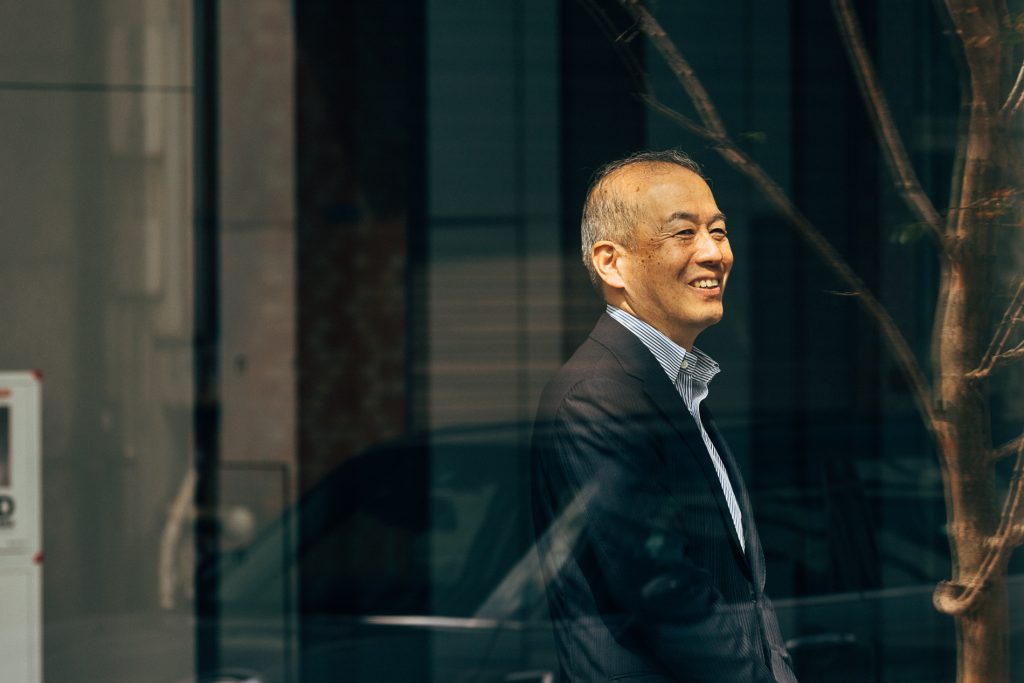
Kiyoyuki Tsuchimoto
After graduating from Keio University in 1982, he joined the Tokyo Stock Exchange, where he worked for 35 years before becoming Senior Managing Executive Officer of Heiwa Real Estate in 2017.
Text : Momoko Suzuki
Photo : Naoto Date
Interview : Akihiro Matsui
Kiyoyuki Tsuchimoto
President, Heiwa Real Estate Co.
Mr. Tatsuo Shioi
President, Prenas Corporation
Interesting people in Kabutocho
Mr. Tatsuo Shioi, the president of Prenas Corporation
“I am interested in Plenus Corporation, which operates HottoMotto and Yayoiken restaurants. Originally, Yayoiken was a Western-style restaurant run by the founder, the great-grandfather of the current president, in Kayabacho. Today, Yayoiken still has its Tokyo headquarters in Kayabacho, but they are growing rice on the roof. He is so obsessed with rice that he has established the Rice Food Culture Research Institute to study the various lifestyle cultures and histories related to rice. I would like to talk to Mr. Tatsuo Shioi, the president of Prenas, about this.
